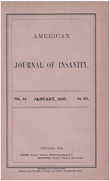Predictors of PTSD in injured trauma survivors: a prospective study
Abstract
OBJECTIVE: The aim of this study was to prospectively examine the relationship between immediate and short-term responses to a trauma and the subsequent development of posttraumatic stress disorder (PTSD). METHOD: All patients consecutively admitted to a general hospital were screened for the presence of physical injury due to a traumatic event. Fifty-one eligible subjects were assessed 1 week and 6 months after the trauma. The initial assessment included measures of event severity, peritraumatic dissociation, and symptoms of intrusion, avoidance, depression, and anxiety. The follow-up assessments added the PTSD module of the Structured Clinical Interview for DSM-III-R--Non-Patient Version and the civilian trauma version of the Mississippi Scale for Combat-Related Posttraumatic Stress Disorder. RESULTS: Thirteen subjects (25.5%) met PTSD diagnostic criteria at follow-up. Subjects who developed PTSD had higher levels of peritraumatic dissociation and more severe depression, anxiety, and intrusive symptoms at the 1-week assessment. Peritraumatic dissociation predicted a diagnosis of PTSD after 6 months over and above the contribution of other variables and explained 29.4% of the variance of PTSD symptom intensity. Initial scores on the Impact of Event Scale predicted PTSD status with 92.3% sensitivity and 34.2% specificity. Symptoms of avoidance that were initially very mild intensified in the subjects who developed PTSD. CONCLUSIONS: Peritraumatic dissociation is strongly associated with the later development of PTSD. Early dissociation and PTSD symptoms can help the clinician identify subjects at higher risk for developing PTSD.
Access content
To read the fulltext, please use one of the options below to sign in or purchase access.- Personal login
- Institutional Login
- Sign in via OpenAthens
- Register for access
-
Please login/register if you wish to pair your device and check access availability.
Not a subscriber?
PsychiatryOnline subscription options offer access to the DSM-5 library, books, journals, CME, and patient resources. This all-in-one virtual library provides psychiatrists and mental health professionals with key resources for diagnosis, treatment, research, and professional development.
Need more help? PsychiatryOnline Customer Service may be reached by emailing [email protected] or by calling 800-368-5777 (in the U.S.) or 703-907-7322 (outside the U.S.).



